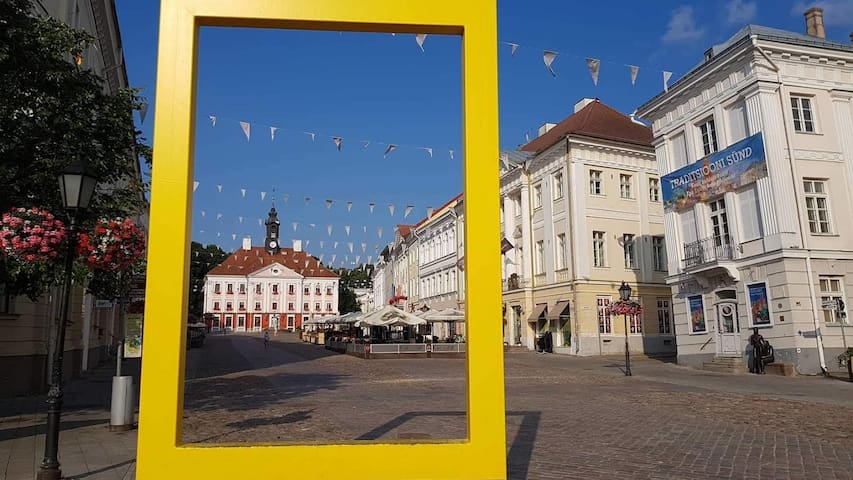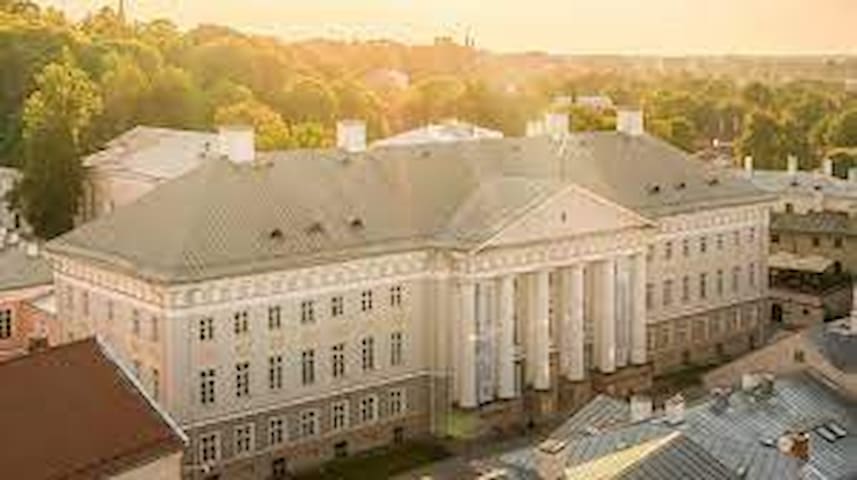City/town information
Tartu Town Hall Square is the trapeze-shaped central square of Tartu, surrounded by classical buildings. The current town hall is the third building that has been erected to that spot. In the 18th century, the square was the location of the most important market in the city – der Grosse Markt, or the Great Market. Since 1998, it has been adorned by the fountain known as the Kissing Students. The Town Hall webcam is available here. Every day, bells ring out from the tower of the Town Hall. Its 18 bells were forged in the bell foundry in Karlsruhe, Germany, and 16 bells were cast for the 15th anniversary of bell-ringing at the Royal Eijsbouts Belfry in the Netherlands. A yellow National Geographic window erected in the Town Hall Square represents Tartu as one of the places in Southern Estonia worth discovering.
8 residents recomanen
Tartu
Tartu Town Hall Square is the trapeze-shaped central square of Tartu, surrounded by classical buildings. The current town hall is the third building that has been erected to that spot. In the 18th century, the square was the location of the most important market in the city – der Grosse Markt, or the Great Market. Since 1998, it has been adorned by the fountain known as the Kissing Students. The Town Hall webcam is available here. Every day, bells ring out from the tower of the Town Hall. Its 18 bells were forged in the bell foundry in Karlsruhe, Germany, and 16 bells were cast for the 15th anniversary of bell-ringing at the Royal Eijsbouts Belfry in the Netherlands. A yellow National Geographic window erected in the Town Hall Square represents Tartu as one of the places in Southern Estonia worth discovering.
Vaatamisväärsused
The Emajõe-Peipsi barge
The Emajõe-Peipsi barge is a unique wooden trading vessel. In Estonia, Peipsi barges sailed the inland waters for more than 600 years – from the 14th until the middle of the 20th cenutry – thus contributing greatly to the prosperity of several Estonian towns, especially Tartu.
When the Hanseatic League dominated trade across the Baltic and North Seas during the 14th-16th centuries, Peipsi barges heading for Novgorod carried mainly salt, cloth, beer, sweet wine and oriental spices. On the return, they brought furs, honey, and wax.
The 19th. century was the prime time for Peip- si barges, when there were more than 500 on Lake Peipsi and around 200 barges could often
7 residents recomanen
Emajõe Lodjakoda
98 UjulaThe Emajõe-Peipsi barge
The Emajõe-Peipsi barge is a unique wooden trading vessel. In Estonia, Peipsi barges sailed the inland waters for more than 600 years – from the 14th until the middle of the 20th cenutry – thus contributing greatly to the prosperity of several Estonian towns, especially Tartu.
When the Hanseatic League dominated trade across the Baltic and North Seas during the 14th-16th centuries, Peipsi barges heading for Novgorod carried mainly salt, cloth, beer, sweet wine and oriental spices. On the return, they brought furs, honey, and wax.
The 19th. century was the prime time for Peip- si barges, when there were more than 500 on Lake Peipsi and around 200 barges could often
Naabruskonnad
The University of Tartu can look back on its 370-year history, symbolised by the statue of Gustav II Adolf, which was re-erected on its original site in Royal Square on St. George's Day in 1992 (created by Elisabeth Tebelius-Myren in 1991 from a plaster figure by Fogelberg) as a symbol of the continuity of alma mater Tartuensis.
The university's main building houses the oldest museum of the university – the art museum. At the university museum in the ancient cathedral on Toome Hill, visitors can get to know the history of the university. Johann Karl Simon Morgenstern opened the university library in the same building 200 years ago. The university's botanical garden, founded in 1803–1806, adds charm to the ruins of the Tartu town wall and the bastion on the right bank of the River Emajõgi.
Student organisations preserve the ideas and keep the traditions of the "student kingdom" of Tartu alive.
Tartu Ülikooli peahoone
The University of Tartu can look back on its 370-year history, symbolised by the statue of Gustav II Adolf, which was re-erected on its original site in Royal Square on St. George's Day in 1992 (created by Elisabeth Tebelius-Myren in 1991 from a plaster figure by Fogelberg) as a symbol of the continuity of alma mater Tartuensis.
The university's main building houses the oldest museum of the university – the art museum. At the university museum in the ancient cathedral on Toome Hill, visitors can get to know the history of the university. Johann Karl Simon Morgenstern opened the university library in the same building 200 years ago. The university's botanical garden, founded in 1803–1806, adds charm to the ruins of the Tartu town wall and the bastion on the right bank of the River Emajõgi.
Student organisations preserve the ideas and keep the traditions of the "student kingdom" of Tartu alive.


